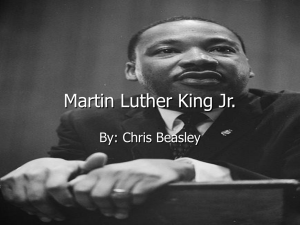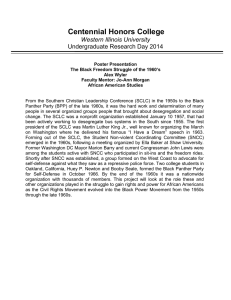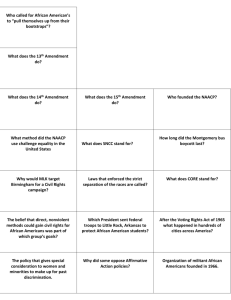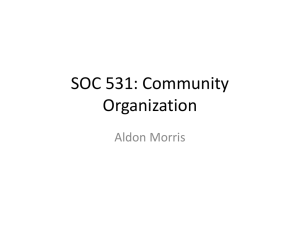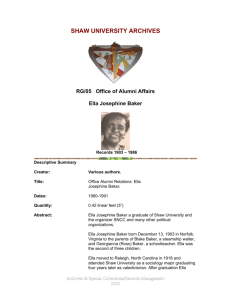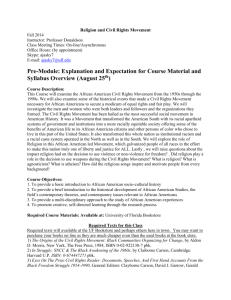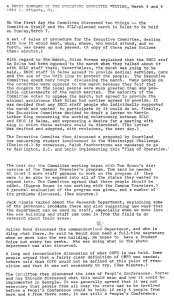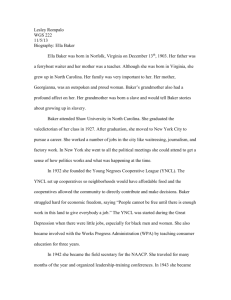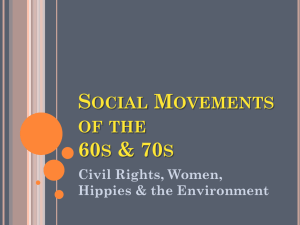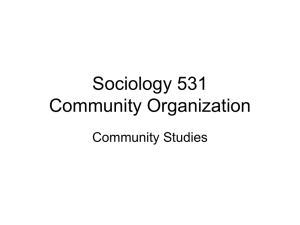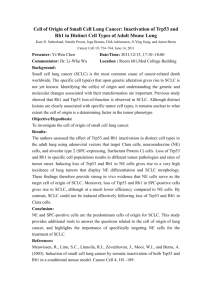Pamela Oliver, lecture/reading notes for Social Movements classes
advertisement
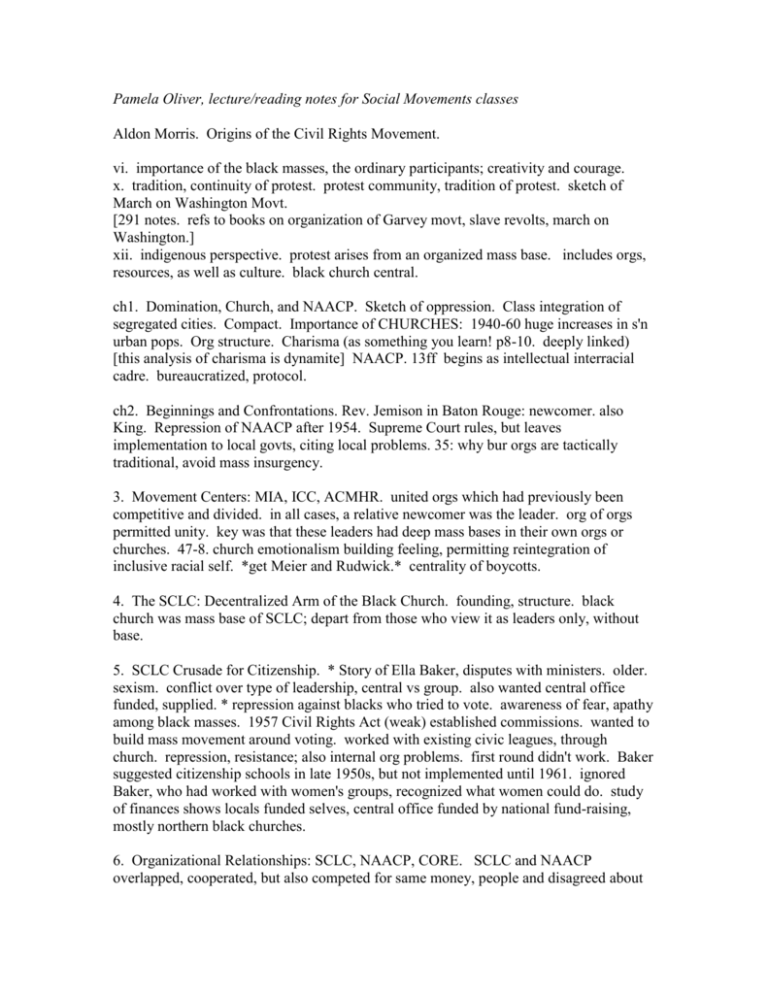
Pamela Oliver, lecture/reading notes for Social Movements classes Aldon Morris. Origins of the Civil Rights Movement. vi. importance of the black masses, the ordinary participants; creativity and courage. x. tradition, continuity of protest. protest community, tradition of protest. sketch of March on Washington Movt. [291 notes. refs to books on organization of Garvey movt, slave revolts, march on Washington.] xii. indigenous perspective. protest arises from an organized mass base. includes orgs, resources, as well as culture. black church central. ch1. Domination, Church, and NAACP. Sketch of oppression. Class integration of segregated cities. Compact. Importance of CHURCHES: 1940-60 huge increases in s'n urban pops. Org structure. Charisma (as something you learn! p8-10. deeply linked) [this analysis of charisma is dynamite] NAACP. 13ff begins as intellectual interracial cadre. bureaucratized, protocol. ch2. Beginnings and Confrontations. Rev. Jemison in Baton Rouge: newcomer. also King. Repression of NAACP after 1954. Supreme Court rules, but leaves implementation to local govts, citing local problems. 35: why bur orgs are tactically traditional, avoid mass insurgency. 3. Movement Centers: MIA, ICC, ACMHR. united orgs which had previously been competitive and divided. in all cases, a relative newcomer was the leader. org of orgs permitted unity. key was that these leaders had deep mass bases in their own orgs or churches. 47-8. church emotionalism building feeling, permitting reintegration of inclusive racial self. *get Meier and Rudwick.* centrality of boycotts. 4. The SCLC: Decentralized Arm of the Black Church. founding, structure. black church was mass base of SCLC; depart from those who view it as leaders only, without base. 5. SCLC Crusade for Citizenship. * Story of Ella Baker, disputes with ministers. older. sexism. conflict over type of leadership, central vs group. also wanted central office funded, supplied. * repression against blacks who tried to vote. awareness of fear, apathy among black masses. 1957 Civil Rights Act (weak) established commissions. wanted to build mass movement around voting. worked with existing civic leagues, through church. repression, resistance; also internal org problems. first round didn't work. Baker suggested citizenship schools in late 1950s, but not implemented until 1961. ignored Baker, who had worked with women's groups, recognized what women could do. study of finances shows locals funded selves, central office funded by national fund-raising, mostly northern black churches. 6. Organizational Relationships: SCLC, NAACP, CORE. SCLC and NAACP overlapped, cooperated, but also competed for same money, people and disagreed about tactics. CORE was N'n org with no mass base until late 1950s, MC white intellectuals. paternalistic. much racial bickering. SCLC all black, but did have to deal with sexism. [which CORE also had to deal with] McCain, teacher fired for saying he was in NAACP. 1957 King joined CORE's advisory committee, helped it fund raise. activist black ministers got involved in CORE. 7. Movement Halfway Houses. isolated from larger society, collections of resources and history, but have no broad support or visible platform. Highlander Folk School. Myles Horton. oppressed people know; the answers to their own problems, teacher's job is to get them talking, raise and sharpen questions, trust people to come up with answers. groups not individuals. trained potential leaders. many key people went there! Septima Clark, theoretician of citizenship schools. Based on St. Johns Island. adults. big ideas, adult atmosphere. studied United Nations Declaration of Human Rights. spread all over south, trained at HFS. HFS didn't want to administer it, turned over to SCLC. Fellowship of Reconciliation. pacifist. gave resources and aid, and transmitted theory and practice of nonviolence. founded CORE. nonviolence as a way of action not natural. FOR started teaching nonviolence to King et al after Montgomery Bus Boycott underway. lectures, workshops, intense training to learn nonviolence. also helped to build will to resist, nonviolently. comic book Martin Luther King and the Montgomery Story written to teach nonviolence; sold big to sociology classes, but also to one of the kids who sat in at Greensboro. Southern Conference Educational Fund. helped SNCC, integrated. interracial, liberal/left. tax exempt; educational, persuasive. focus on overthrow segregation. stressed white support for black struggle, class interests. 8. Internal Org and Direct Action. Nashville. 4 black colleges, strong churches. major center of SNCC. Louisiana, Texas, Virginia. [often get a sense of self-serving stories.] Sit-ins at least 16 early ones. intentional, grow from civil rights orgs, people know each other. telephone calls, information and support. but no mass base (CORE and NAACP youth council.) 9. 1960s: Origins of a Decade of Disruption. Feb 1 - Apr 1 1960, sit ins in at least 70 cities. black colleges: students free to protest, although teachers and administrators often tried to stop (fear of losing funding from state legs). close links of students to churches, civil rights orgs. past tests, trainings. after Greensboro, training session and organizing. Shuttlesworth called Baker about the action, who started callling everyone she knew at colleges: What are you all going to do? It is time to move. SCLC jumped on board and provided support, leadership, planning. [but didn't start it. "This is it. Let's go."] Border and seaboard states wehre repression weaker, permitted denser networks, organizations. temporal and geographic clusters. deep south later, not clustered; only where existing movement centers. sit-ins gave new life to movement, new energy. SCLC raised money from the sit-ins (which they didn't do) but also paid bail and paid for support, felt they deserved the money. SNCC created to coordiante local struggles. Ella Baker brought students together. 1960. disputes about whether could have or would have joined SCLC, but stayed separate. northern white students picked up the tactic, toook model. * SDS models self after SNCC. * SCLC organizes fundraising more carefully, manages King's time (money comes from his speeches), takes advantage of sit-in waves. 10. Birmingham. Forman (per A Braden): "Just because you don't have a structure and you don't have leaders doesn't mean that nobody is running things. It just means you don't know who is running it." * Freedom Rides. started by CORE May 1961. not a mass tactic. spread, became mass, SNCC involved, NAACP in legal services and financing. *Kennedy admin tries to keep SNCC on voter reg. * SCLC citizenship schools. provided mobilizing base for more militant parts of movement. * Albany Georgia. Dec 61 - 1962. SNCC mobilized, starting with the students, esp high school. but also worked with ministers. campaign against all of segregation. many demonstrations, sit-ins. paralyzed the city. but couldn't force concessions. massive arrests but no police violence. SNCC could stimulate, but poor management, planning. King invited in by Anderson, makes SNCC made. King maneuvered out of town. gets arrested again, maneuvered out again. then injunction, which King decides to abide by. splits movement. white power structure strong, sensible. * Birmingham. needed the right enemy. very careful planning. 1963. explicitly iron out organizational relations. get leverage through disruption and boycott. money downtown. target goal. separate economic and political elites. religious fervor helps encourage bravery. boycott and massive disruption. 11. conclusion. SM theory and the indigenous approach. Contra "collective behavior" theory, protest was not spontaneous or discontinuous with institutional behavior, but planned, organized, and built upon preexisting organizations. Weber's charisma, but importance of linking charisma to organizations. Resource mobilization, importance of third parties. Agrees about resources, but disagrees about centrality of outsiders. Indigenous perspective focuses on dominated communities, need fro basic resources, activists with ties to mass-based institutions, effective tactics/strategies. Movements deliberately organized, not a product of resources. Local movement center as distinctive form of organization. Discussion of organizational forms and leadership, charisma in non-bureaucratic organizations. Impact of CRM in improving lives for Blacks, and in creating new models of protest.
